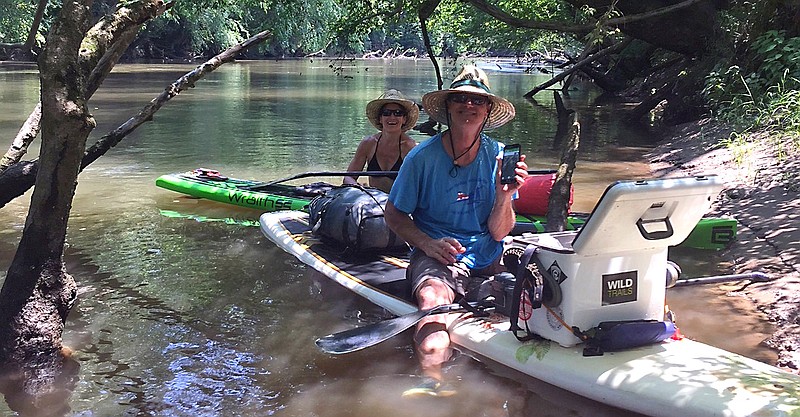I was not a water person by nature. I didn't learn to swim until I was in my early 30s, and then only because I wanted to compete in a triathlon. But then I married a water person.
I came to stand-up paddleboarding in 2014 after my husband Randy fell in love with it. He lives for weeklong SUP trips with high-mileage days. I grew up backpacking and camping in Colorado, so that part, at least, seemed doable. Then, last summer, I took my first overnight SUP trip: three days on the French Broad River in North Carolina.
I learned a lot through that experience. For instance, the main thing with SUPing is to pay attention to the water just ahead of you in order to spot any hazards that may damage your board. Although you are on what seems to be a flat board, you have a rigid fin hanging down about 8-9-inches beneath the back of your boat. You need this to be able to move the board in the direction you want it to go, but you also need to be aware of it as you navigate over debris.
Ready to go?
There are a number of fun overnight paddling trips to plan along Chattanooga waterways. Visit getoutchattanooga.com for some itineraries. And be sure to flip to page 44 for a unique blueway paddle in our region.
I also learned that with a few important pieces of gear and proper preparation, SUP camping is easy.
Get yourself in gear
The two most important pieces of gear are a personal flotation device (AKA life jacket) and a waterproof gear bag, or dry bag.
The best kind of flotation device for SUPing can be clipped around your waist.
Dry bags or gear bags come in a variety of sizes. What you wish to take will help you determine how many bags you need and the size of each. For a one- or two-nighter, Randy and I use one 5-liter bag each for clothing, and an 11-by-3-by-10-inch bag for our shared items, including food and stove.
Here is a breakdown of what else you'll want to take.
1. Camp gear
»Tent: A tent gives you space and protection, but there are two other options for a paddler traveling or sleeping alone. A bivouac bag, a collapsible bag made of weatherproof fabric; or a hammock. With the hammock, look for an option with a rain fly and all the necessary straps to attach to trees. The hammock allows you to leave your sleeping pad at home since you are sleeping off the ground.
»Sleeping pad
»Lightweight sleeping bag
2. Cellphone
Portable battery for cellphone: These can be purchased online or at most outdoor sporting goods stores.
3. Repair gear
»Tape: Gorilla tape is waterproof and can be used to repair a board puncture from a submerged log or sharp rock, or even a broken paddle.
»Quick-drying epoxy: Another quick way to repair holes on fiberglass boards.
4. Cook gear
»Camp stove: A Jetboil or Foxelli are good options. The Jetboil uses gas and a traditional lighter or matches. The Foxelli is even more portable and needs an electric arc lighter, which can be charged with the portable battery for a cellphone.
»Water filter or purifier
»Cup
»Bowl
»Utensils: Sporks work well.
»Zip-lock or plastic grocery bags to pack out trash
5. Food
»Camp food: Try Full Circle's organic brown rice and quinoa or Tasty Bite's Indian and Thai food.
»Instant oatmeal
»Dried fruit
»Nuts
»Protein/fruit bars
»Dehydrated meats
»Starbucks VIA instant coffee packets
6. Clothing
Even in the summer, warm clothing is necessary if you get wet and chilled. Plan for what you might need and what you have room for.
»Fleece pullover
»Fleece pants
»Lightweight long-sleeve wool shirt
»Rain jacket
»Sun hat with a wide brim
»Gloves: My hands tend to get cold easily so I usually pack lightweight wool glove liners. If the weather is cold, some neoprene paddling gloves can be a lifesaver.
»Wool hat
»Wool socks: On a SUP, your feet can be cold for a good part of the day. Warm them up at night.
»Windbreaker: This is a nice option if you aren't expecting rain. It tends to be lighter-weight than a rain jacket, and usually water resistant. I've used a Patagonia Houdini for the last 10 years.
»Water shoes: I use Crocs because they have padding and an ankle strap, but you could also try some neoprene booties.
»Sandals
»Sunscreen
7. Nice-to-haves
»Navigational or mapping apps like ViewRanger, which you can download on your phone and use to follow a route or to map a track and mark your stops.
»Waterproof camera
»Binoculars
»Folding camp chair
»Bungee cords or tie-down straps to affix your dry bags and other gear to your board. When it comes to fastening all your gear onto your board, tie-down stick-ons are essential. Tie down stick-ons are pieces of super-sticky neoprene, plastic or leather, allowing you to use their loops to strap down packs.
»A small waterproof container, such as an ammunition can or dry box, to carry for easy access to personal items such as eye drops, lip moisturizer or first aid.
»A cooler
»Toilet paper
»A chocolate bar
PRO TIPS:
»Go for a test run with your gear-laden boat so you can see how the extra weight feels. This allows you to strap your gear on and make sure it feels balanced and secure.
»Don't forget that you can stow items behind your feet as well as in front of them. You may find the space behind your feet is perfect for your dry bag with your tent, tightly rolled sleeping pad and some of your clothes. Heavier items should be in front of your feet.
»Practice falling off your board and climbing back aboard to get a feel for it.
»If you decide to load ViewRanger, practice using it a bit at home as you walk around your neighborhood until it feels comfortable.
